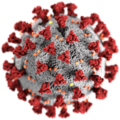Portal:Pathogens/Selected article
- These are selected articles related to Pathogens which appear on Portal:Pathogens.

The Epstein-Barr virus (EBV) or HHV4 is a herpesvirus. The most common cause of infectious mononucleosis or glandular fever, it infects 90% of adults worldwide. It has been implicated in numerous immune diseases including chronic fatigue syndrome, multiple sclerosis, myasthenia gravis, and systemic lupus erythematosus. It is known to turn on "risk genes" for autoimmune disease in the cells it infects. (more...)

Coxsackie B (also written coxsackievirus B) is a group of six types of enteroviruses, causing symptoms ranging from gastrointestinal distress to pericarditis and myocarditis. Symptoms of infection with viruses in the Coxsackie B grouping include fever, headache, sore throat, gastrointestinal distress, extreme fatigue as well as chest and muscle pain. (more...)

Lyme disease (Lyme) a chronic illness which causes severe fatigue and it's often misdiagnosed as ME/CFS. Lyme disease is caused by the pathogen borrelia burgdorferi, which is passed on through bites from infected deer tick. (more...)

Many different subtypes of flu exist, with Influenza A and Influenza B being the most medically serious. The 2009 swine flu epidemic was caused by a new strain of Influenza A, known as subtype H1N1. (more...)

Enteroviruses are a class of non-enveloped positive single-stranded RNA viruses. Enteroviruses include Coxsackievirus A, Coxsackievirus B, Echovirus, Poliovirus, Rhinovirus, and many others. Person-to-person transmission of enteroviruses occurs through fecal-oral and oral-oral routes. Non-polio enteroviruses are very common (more...)
Human herpesvirus 6 (HHV-6) is a virus caught by most of the population in infancy. HHV-6 can be dormant in the body and reactivate many years later. HHV-6 has been linked to a number of illnesses including multiple sclerosis (read more...)


